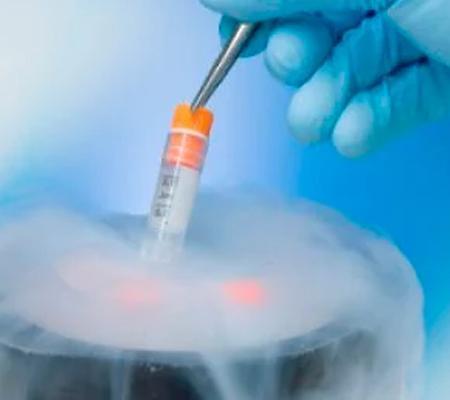Vitrification
Vitrification of Embryos
Freezing of human sperm, eggs, and embryos
Within the laboratory at Laparoscopy Center In Nashik we have a tissue bank where we freeze and store oocytes (eggs), sperm and embryos for our patients. The bank has a full-time manager under supervision. All tissue in the bank is stored frozen in liquid nitrogen at a temperature of -1960C in vacuum lined tanks that are computer controlled and monitored 24 hours a day with a state of the art alarm system. The embryologists are responsible for maintaining the bank and no other PFC employee has access. Nashik Fertility Center is best Laparoscopy center in Nashik and has best Laparoscopy specialist in Nashik also.

- Freezing Sperm
- Freezing and storing human embryos
Scientists have been freezing sperm for decades and as a result, the technology for preserving and storing sperm is well defined. At Laparoscopy Center In Nashik we are freezing sperm samples almost every day, which are then stored frozen until they are needed. We also receive frozen sperm from sperm banks and other tissue banks that we store until the patient is ready to use. Sperm tolerate the freezing process well, although we do see some variation from patient to patient. Many patients freeze sperm for convenience (say a husband knows that he will be traveling on the day we will be performing an insemination on his wife), but for most patients, there is a specific reason to freeze the sperm. We perform surgeries for some men to harvest sperm from the epididymis or testicle, and this sperm is frozen in several aliquots to help the patient avoid having to have the surgery again in the future. For others, sperm numbers are low and we try to accumulate sperm in the freezer to allow the couple to do inseminations or IVF. We also will suggest sperm freezing for any man who may be anxious about producing a sample on the day of his partner’s insemination or egg retrieval.
When sperm is thawed from the bank it is normal for some of the sperm to die. Not all cells survive freezing and thawing, but since most sperm samples have many millions of live sperm, losing a small fraction of them has little consequence. However, it is important to be aware of the expected drop in the number of live sperm after freezing so that enough sperm can be frozen up front for the purpose of having one or more pregnancies. If you reference the visual representation of the process of freezing sperm above, you will see that the sperm is stored in carefully labeled vials (1) and placed in a cooling tank (2). The vials are then placed in a tray (3), slid into a labeled storage drawer (4) and lowered into a nitrogen tank (5).
Our experience with freezing embryos is not quite as substantial as with freezing sperm. Nevertheless, since the first human embryos were successfully frozen back in 1984, hundreds of thousands of babies have been born from embryos that spent some time in the freezer. Embryo freezing is a very routine part of the IVF process and approximately 60% of patients end up with some embryos in storage.
Freezing of excess good quality embryos after IVF allows for the transfer of fewer embryos in the stimulated IVF cycle and, therefore, ensures fewer high-order (triplets or more) multiple births. This process provides patients with a “back-up” should the initial fresh embryo transfer not result in a pregnancy, at a much lower cost than starting IVF all over again and often with minimal medications. Frozen embryo transfers have allowed many of our patients to achieve more than one pregnancy from a single cycle of ovarian stimulation. Embryos can be frozen at any stage of development during the IVF process. Eggs that are fertilized can be frozen as early as 1 day after an egg retrieval procedure, but it is more common to allow embryos to develop for a number of days before freezing them. This allows us to observe how well the embryos are developing so that we only end up with embryos in the freezer that we think have a good probability of establishing a pregnancy.
Embryos tolerate freezing very well and we expect over 90% of embryos to survive the process. Pregnancy rates with frozen/thawed embryos are as good as pregnancy rates for embryos that were transferred fresh without ever being frozen.
